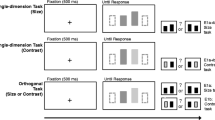Abstract
Linear programming problems were presented, in a predominantly visual setting, to high school students who were not acquainted with any specific methods for solving such problems. The strategies developed by the students for coping with these problems were identified and classified. Visual strategies were developed more frequently than either algebraic or mixed ones. In many cases, these visual strategies were unsophisticated. Providing the students with a visual solution tool (a level curve of the target function) did not lead to significant changes.
Similar content being viewed by others
References
Bondesan, M. G. and Ferrari, P. L.: 1991, ‘The active comparison of strategies in problem solving: An exploratory study’, in F. Furinghetti (ed.),Proceedings of the Fifteenth International Conference on the Psychology of Mathematics Education, Assisi, Italy, Vol. I, pp. 168–175.
Case, R.: 1978, ‘A developmentally based theory and technology of instruction’,Review of Educational Research 48(3), 439–463.
Clements, M. A.: 1984, ‘Terence Tao’,Educational Studies in Mathematics 15(3), 213–238.
Collis, K. F. and Watson, J. M.: 1991, ‘A mapping procedure for analyzing the structure of mathematics responses’,Journal of Structural Learning 11(1), 65–87.
Dantzig, G. B.: 1963,Linear Programming and Extensions, Princeton University Press, Princeton, NJ.
Eisenberg, T. and Dreyfus, T.: 1991, ‘On the reluctance to visualize in mathematics’, in W. Zimmermann and S. Cunningham (eds.),Visualization in Teaching and Learning Mathematics, Mathematical Association of America, pp. 25–38.
Noelting, G.: 1980, ‘The development of proportional reasoning and the ratio concept’,Educational Studies in Mathematics 11(2), 217–255 and 11(3), 331–363.
Presmeg, N.: 1986, ‘Visualization and mathematical giftedness’,Educational Studies in Mathematics 17(3), 297–311.
Shama, G. and Dreyfus, T.: 1991, ‘Spontaneous strategies for visually presented linear programming problems’, in F. Furinghetti (ed.),Proceedings of the Fifteenth International Conference on the Psychology of Mathematics Education, Assisi, Italy, Vol. III, pp. 262–269.
Vinner, S.: 1989, ‘Avoidance of visual considerations in calculus students’,FOCUS on Learning Problems in Mathematics 11(2), 149–156.
Wilkening, F. and Lange, K.: 1990, ‘When is children's perception holistic? Goals and styles in processing multidimensional stimuli’, in T. Globerson and T. Zelniker (eds.),Cognitive Style and Cognitive Development, Ablex, Norwood, NJ.
Author information
Authors and Affiliations
Rights and permissions
About this article
Cite this article
Shama, G., Dreyfus, T. Visual, algebraic and mixed strategies in visually presented linear programming problems. Educ Stud Math 26, 45–70 (1994). https://doi.org/10.1007/BF01273300
Issue Date:
DOI: https://doi.org/10.1007/BF01273300




